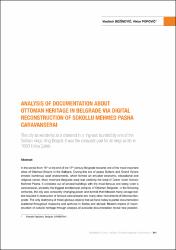Analysis of Documentation About Ottoman Heritage in Belgrade Via Digital Reconstruction of Sokollu Mehmed Pasha Caravanserai
Künye
BOZİNOVİC, Vladimir & Victor POPOVİC. "Analysis of Documentation About Ottoman Heritage in Belgrade Via Digital Reconstruction of Sokollu Mehmed Pasha Caravanserai." Balkanlarda Osmanlı Vakıfları ve Eserleri Uluslararası Sempozyumu, (2012): 341-352.Özet
In the period from 16th to the end of the 17th century Belgrade became one of the most important
cities of Ottoman Empire in the Balkans. During this era of peace Sultans and Grand Viziers
erected numerous waqf endowments, which formed an enviable economic, educational and
religious center. Most important Belgrade waqf was certainly the waqf of Grand Vizier Sokollu
Mehmet Pasha. It consisted out of several buildings with the most famous one being vizier`s
caravanserai, probably the biggest architectural complex of Ottoman Belgrade. In the following
centuries, the city was constantly changing power and turmoil that followed many savage battles
resulted in destruction of famous caravanserai and many other monuments of Ottoman Belgrade.
The only testimony of these glorious objects that we have today is partial documentation
scattered throughout museums and archives in Serbia and abroad. Modern means of reconstruction
of cultural heritage through analysis of available documentation reveal new possibilities for further study and presentation of Ottoman heritage in Belgrade. Now we can revitalize
politicized or neglected historic heritage with virtual forms of presentation which would promote
cultural tolerance and real identity reference of Belgrade.
This approach will be discussed through the example of digital reconstruction of Sokollu Mehmet
Pasha caravanserai.



















